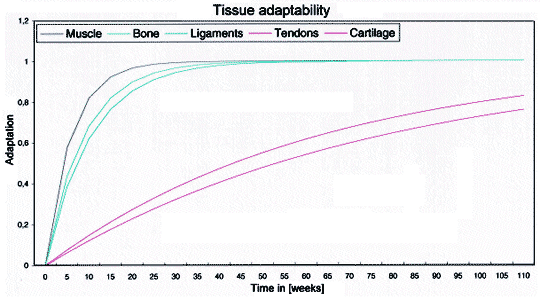What are bones made of?
Bones are made mostly of collagen, as bone is living, growing tissue. Collagen is a protein that provides a soft framework, and calcium phosphate is a mineral that adds strength and hardens the framework. This combination of collagen and calcium makes bone strong and flexible enough to withstand stress.
Within our bones are special cells that constantly break down and build new bone. Osteoclasts break down bone, and the do the cleaning up while osteoblasts build new bone through a process called ossification. From childhood through the teen years, the body adds new bone more quickly than it can remove old bone. This helps to build bone mass, or bone density. The more active we are as children, the bigger and stronger our bones will be. As we hit our peak bone mass around the age of 25, our lifestyle and exercise routine from then will play a major role in ensuring we maintain healthy bones.
How does movement and exercise or lack of it change bone health?
Chronic Physical Activity and Bone Health.
Chronic physical activity leads to:
– Increases in Bone density
– Increases in Bone compressive strength
– Increase in Bone stiffness (to a certain threshold)
– Increase in geometric size of bone (bone mass)
Chronic Disuse and Bone Health.
Chronic disuse and lack of exercise results in:
– Decrease in bone density (up to 1% per week bed rest!)
– Decrease in bone strength
– Decrease in bone stiffness
Consider the Rate of Adaptation!
What does this mean? As we exercise, our body will go through several changes. The tissue in the body, depending on the exercise, the rate of application (how quickly we exercise/move/push or pull), and the load applied (how much we lift/push or pull) during this application, will undergo changes. The rate of this change in the tissue will depend heavily on the tissue adaptability.
Each tissue in the body will take different time to repair, regenerate and grow new tissue in response to exercise, movement or damage. This is important in the planning and application of training stressors to ensure there is minimal chance of injury through excessive load, rate of load and the time allowed to recover.
So, with that in mind, what tissue is the quickest to recover? And what is the slowest? As you might expect, muscle is the quickest tissue to recover in response to exercise. Next? Well, looking at this article, may give you a hint. Bone has the second quickest rate of adaptation, or tissue adaptability is response to exercise. From there, it is ligaments, tendons and finally cartilage as the slowest to adapt, or displays the lowest tissue adaptability.

Looking at bone health. Bone mineral density (BMD) changes are the main factor for determining or assessing exercise-induced bone health improvements, this is despite several studies findings displaying that improvements in bone mechanical properties are independent of changes in bone mineral density (BMD). (1) So what does this mean? Bone mineral density is purely is measurement or indication of the mineral content of bone. It does not discuss or cover the geometrical shape or size of the bone, the cortical to trabecula bone ratio, the bone mass, the compressive strength or its Young’s modulus. (stress/strain ratio). All of these factors related to bone health can be improved with exercise, in specific resistance training.
The mineral’s in bone refer to calcium, phosphorus and a few other minerals. When we exercise, the bone undergoes stress and strain from the pulling, compressive and torsional force exerted by the working muscles when moving, exercising, lifting weights etc.
Chronic physical activity has positive effects on bone health. Bone density, bone geometry, stiffness at certain thresholds and geometric adaptation or increase in diameter. These are all positive outcomes for health from physical activity. For general health and wellbeing, moving more and sitting less and pick up the pace when and where you can all have positive benefits on your muscles and bones. This will only help in reducing the onset of strength and mobility losses associated with ageing. Maintaining quality of life and activities of daily living are keys to independence in the future.
As the old saying goes, if you don’t use it, you will lose it. Nothing is more true than this statement related to your health and fitness. Muscle strength, power, flexibility, muscle mass, muscle quality, bone strength, bone mass and size are transient properties. They are in constant change, and unless we are active and use these abilities, we lose them quicker as we get older.
1. Fonseca H, Moreira-Goncalves D, Coriolano HJ, and Duarte JA. Bone quality: the determinants of bone strength and fragility. Sports Med 44: 37-53, 2014.